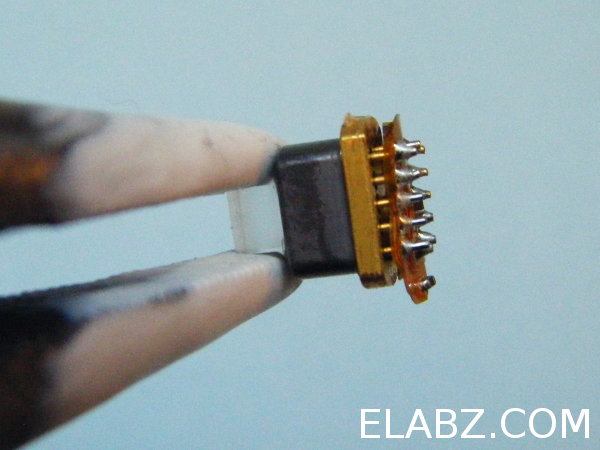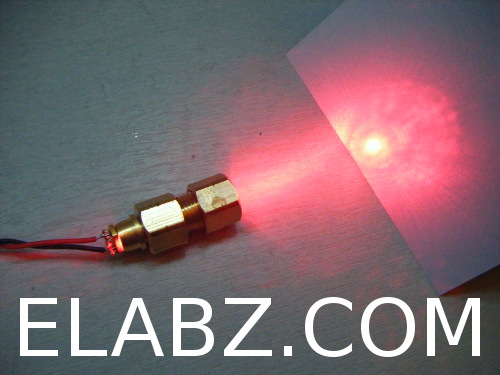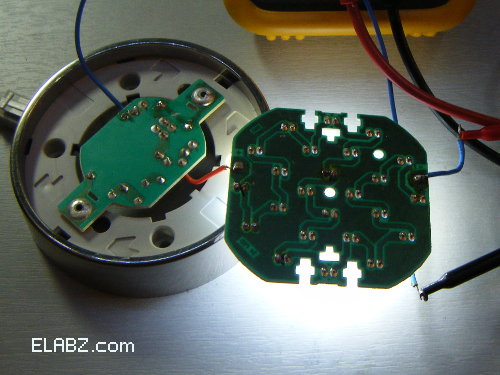Laser Diode Driver Based on LT1121 Voltage Regulator – schematic and PCB

Laser diode driver based on LT1121. PCB version 1.2, populated.
This post is kept alive just to hold the old comments – please see the corrected circuit design here: http://elabz.com/ttl-controlled-laser-diode-driver/
Update
I’m having some issues with overheating of both the LT1121 IC and the R1 potentiometer, so I advise you to approach this design with caution. I will be revising it in near future. I would love to hear any suggestions for improving this design from the site visitors!
{adinserter Internal_left}I’ve been using an off-the-shelf laser diode driver for my CNC laser cutting projects and came to realize that I need a different driver. Maybe not so small as to fit inside the laser diode enclosure but capable of driving both red diodes in 100mA-200mA range and blue diodes in 75mA-130mA. In fact, having the driver inside the laser diode housing proved to be inconvenient for this application because it is hard to monitor the current and also both the driver and the diode emit considerable amount of heat and I see no good reason to put them together to double that heat up inside a small enclosed space. Read the rest of this entry »
DVD teardown – Toshiba TS-L462 CD-RW/DVD drive

Toshiba TS-L462 CD-RW/DVD drive ready to be disassembled
Laser Diode Power Output Based on DVD-R/RW specs

Unknown red laser diode - what performance can we expect? - Elabz.com
{adinserter Internal_left}I’ve opened about a dozen different types of CD and DVD drives so far (of both read-only and burner varieties) and every time it’s a thrill to find a working red laser diode in there. But it would be useful indeed to know what performance can be expected from the laser diode once it’s free of its mounting hardware (AKA “sled”) – if it’s the laser diode you’re after, the drive may not even be worth opening. It would be nice to know that before wasting some time on opening it. Although it would be hard to know the exact specs of the diode down to the part number, some of the specs can be found rather quickly doing an Internet search. Here is how I do that.
Read the rest of this entry »
Laser Diode Housing from Hardware Store Parts

Laser Diode Housing, MacGyver'ed. The focus is not THAT horrible, the camera picked up too much splatter.
It’s a weird looking laser diode (LD) that is mounted in the same case with the photodiode arrays which makes for simplified optics but I did not have any housing for this shape/size diode. By the way, if anyone reading this knows a professionally made housing for this type of LD, please post a comment with the reference, I would greatly appreciate that. The diode is just slightly smaller than your more standard 9mm LD – it’s smaller diameter is 6.50mm and the larger diameter is 8.25mm so it fits neither 5.6mm nor 9mm standard size housings.
This made me think that I may not be the only one stuck without a proper housing for a laser diode and I decided to see what it would take to build a housing for a laser diode out of parts available only in the disassembled drive itself and in a local hardware store. Here is what came out
Read the rest of this entry »
Driving a Bipolar Stepper Motor with Arduino and ULN2803AG
{adinserter Internal_left}While I’m getting ready to rip open some 10+ broken DVD-RW drives coming to me from an eBay seller, I though it would be great to have a testbed for the bipolar stepper motors I will harvest from those.
I have a bunch of ULN2803AG Eight Darlington Transistor Arrays with Common Emitters left from past projects and these can sink (but unfortunately not source) peak loads of 600mA (500mA continuous) and are well suited for power application like driving small motors. However, there is a problem with 4-wire bipolar stepper motors: they don’t have the common points of windings wired to the outside which would be needed for providing the motors with power. See the ULN2003 datasheet for more information about the IC: ULN2801,2802,2803,2804 and 2805 Darlington Array datasheet
Read the rest of this entry »
CNC files for Bumblebee – the miniature laser cut rocket
{adinserter Internal_left}I’m going to build the Groover’s Pocket Laser Engraver at some point in the future but so far not much luck with CD drives I’m disassembling (two so far). Both were very old drives (1996 and 1998) and (shocker!) things were much simpler back then Read the rest of this entry »
CNC files for laser cut miniature airplane model – Supermarine Spitfire
 Postal stamp sized model of Supermarine Spitfire MKII
Postal stamp sized model of Supermarine Spitfire MKII
{adinserter Internal_left}
The idea for this model came to me when I was browsing Instructables and came upon this nice project – the Pocket Laser Engraver. Basically, its author, Groover, describes building a laser diode cutter not unlike the one I’m using here but based on parts of discarded DVD-RW drives. In fact, the diode he’s using is also salvaged from one of those drives. I got intrigued by the project due to the fact that I never throw anything electronics away and I have a little stash of CD and DVD drives myself that I would love to put to some fun use.
G-Code CNC Files for the rocket
Hacking Lights of America 7200LED-BN LED Lights

Lights of America 7200LED-BN LED Lights being hacked
{adinserter Internal_left}The earlier post about repairing the Lights of America 7200LED-BN lights has generated quite a few comments and provided for a lively discussion but I end it at a rather pessimistic note: ” you can repair it now but eventually the light will fail again”. That’s because this has been my experience with all lights I’ve repaired so far. They have 24 original LEDs and after just a few hours of use another LED inevitable burns out.
Encouraged by one of my visitors, CharlySays , I decided to investigate the issue further and see if anything can be done to increase the useful life of these lights. Besides, the lights have been dark for almost half a year now and I was ready to remove them from under the cabinet and possibly replace with mini CFL lights of a similar form factor.
Keep reading for the results of the hacking exercise: Read the rest of this entry »
Repairning Seagate 7200.11 Drive on a Ubuntu 10.04 Computer – a Success Story!

SATA drive Serial TTL interface socket
{adinserter Internal_left}When your friends and family are asking you: “So, how did you spend your weekend?” , wouldn’t you want to be able to hold your head up and proudly say: “I had successfully un-bricked my Seagate 7200.11 hard drive, what did you do?”.
I’ve found myself in a strong need of a SATA drive and the only ones I had on hand were two Seagate ST31000340AS 1000GBytes drives of the Barracuda 7200.11 clan that had silently died in my RAID array over the course of last year. I bought the replacements but it looked quite odd that the original ones died before reaching 18 months of age and I kept them safely in a box until I had time (and strong enough need) to try and figure out what’s wrong with them.
It turns out, I was not the only one having problems with these drives (far from it) and many people have successfully repaired them and posted enough detail on the Net for someone else to repeat the procedure. This post is not meant to be a detailed description of the procedure and the underlying issues with the drive’s firmware – there are many places where you can read about it and I’ll provide links below – this post describes just one way of doing it. I also wanted to illustrate that, although most instructions call for the use of a Serial-to-TTL adapter, there are other devices that can take its place. Also, most of instructions I’ve seen are based on Windows software and I thought Linux users like myself could use some more references Read the rest of this entry »




